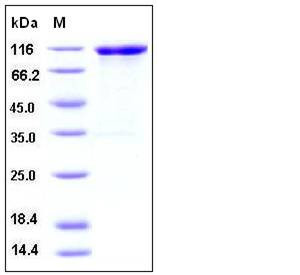Mouse VCAM1 / CD106 Protein (His & Fc Tag)
CD106,Vcam-1
- 100ug (NPP3534) Please inquiry
| Catalog Number | P50163-M03H |
|---|---|
| Organism Species | Mouse |
| Host | Human Cells |
| Synonyms | CD106,Vcam-1 |
| Molecular Weight | The recombinant mouse VCAM1/Fc is a disulfide-linked homodimer after removal of the signal peptide. The reduced monomer consists of 922 amino acids and has a predicted molecular mass of 102 kDa. In SDS-PAGE under reducing conditions, the apparent molecular mass of rmVCAM1/Fc monomer is approximately 110-120 kDa due to glycosylation. |
| predicted N | Phe 25 |
| SDS-PAGE |  |
| Purity | > 90 % as determined by SDS-PAGE |
| Protein Construction | A DNA sequence encoding the extracellular domain (Met 1-Glu 698) of mouse VCAM1 (NP_035823.3) precursor was fused with the C-terminal polyhistidine-tagged Fc region of human IgG1 at the C-terminus. |
| Bio-activity | Measured by the ability of the immobilized protein to support adhesion of U937 human histiocytic lymphoma cells. When cells are added to VCAM1-coated plates (10 μg/ml, 100 μg/well), approximately >70% cells will adhere specifically. |
| Research Area | Immunology |Signal Transduction |Cytoskeleton / ECM |Cell Adhesion |Cell Adhesion Molecules |
| Formulation | Lyophilized from sterile PBS, pH 7.4 1. Normally 5 % - 8 % trehalose, mannitol and 0.01% Tween80 are added as protectants before lyophilization. Specific concentrations are included in the hardcopy of COA. |
| Background | Vascular cell adhesion molecule 1 (VCAM-1), also known as CD106, is a cell surface sialoglycoprotein belonging to the immunoglobulin superfamily. Two forms of VCAM-1 with either six or seven extracellular Ig-like domains are generated by alternative splicing, with the longer form predominant. VCAM-1 is an endothelial ligand for very late antigen-4 (VLA-4) and α4ß7 integrin expressed on leukocytes, and thus mediates leukocyte-endothelial cell adhesion and signal transduction. VCAM-1 expression is induced on endothelial cells during inflammatory bowel disease, atherosclerosis, allograft rejection, infection, and asthmatic responses. During these responses, VCAM-1 forms a scaffold for leukocyte migration. VCAM-1 also activates signals within endothelial cells resulting in the opening of an "endothelial cell gate" through which leukocytes migrate. VCAM-1 has been identified as a potential anti-inflammatory therapeutic target, the hypothesis being that reduced expression of VCAM-1 will slow the development of atherosclerosis. In addition, VCAM-1-activated signals in endothelial cells are regulated by cytokines indicating that it is important to consider both endothelial cell adhesion molecule expression and function during inflammatory processes. |
| Reference |
